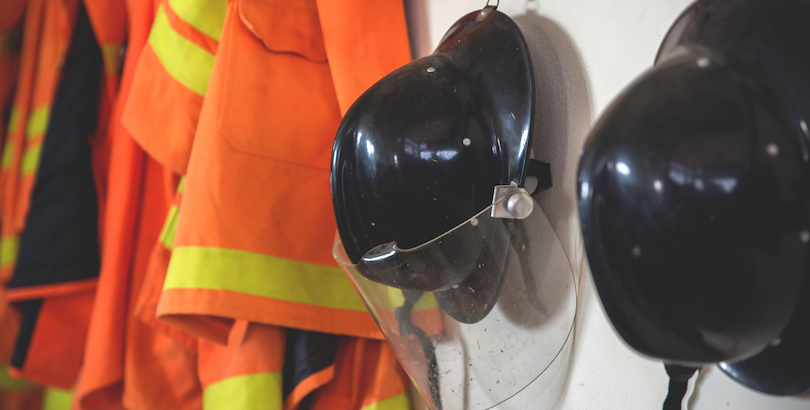For non-combustibility and insurance savings, one building material has an edge. 5 reasons why cold-formed steel framing stands out for fire safety.
Every 20 seconds. That’s how often firefighters in the United States respond to a fire. Fire is the nation’s fifth leading unintentional cause of injury and death. No wonder North American building codes require materials and assemblies that limit fire hazards. In this area, one material stands apart from the others: steel.For superior fire safety, wall and floor construction should feature cold-formed steel (CFS) framing. Here’s why:
1. Steel is non-combustible
Steel can’t burn, because it contains no elements that can serve as fuel. Steel provides no means for a fire to start, it does not contribute to fire growth or fire spread, and it does not contribute to the generation of smoke and toxic combustion products in fires.Building codes recognize steel framing as non-combustible construction. The codes make CFS eligible for use in Type I buildings, which have the most stringent fire-resistance requirements. CFS framing is also common in Type II buildings, which are required (with few exceptions) to be built of non-combustible materials. Buildings of non-combustible construction Types I and II are permitted to have larger areas and heights compared to buildings of combustible construction types, because non-combustible construction contributes to reduced risks of fire ignition, fire growth, and fire spread.
2. Steel maintains its non-combustibility
Steel remains non-combustible throughout the entire lifecycle of the building — during building construction, occupation, and future renovation and repair.The melting point of steel is approximately 2,700 degrees Fahrenheit. Since building fire temperatures average 1,000 degrees Fahrenheit, and rarely exceed 1,800 degrees Fahrenheit, the steel in structures will not melt. While the stiffness and yield strength of steel are reduced at ultra-high temperatures, modern building codes and fire protection methods take these reductions into account.
3. Steel-framed buildings lower the fire risk to workers and occupants
Decades of research into understanding the behavior of structural steel components when exposed to fire has given designers the confidence to engineer buildings that will provide optimum fire safety.Fire resistance-rated walls and floors help limit or slow the spread of flames in a building and maintain the integrity of the structure. Tests conforming to ASTM E119 (Standard Test Methods for Fire Tests of Building Construction) have proven that CFS-framed assemblies are fireproof up to four hours.
A Guide to Fire & Acoustic Data for Cold-Formed Steel Floor, Wall & Roof Assemblies is a searchable directory of fire-rated assemblies for both load-bearing and non-load-bearing conditions. The directory is based on fire test data from Underwriters Laboratories of Canada, National Research Council of Canada, Underwriters Laboratories Inc., Gypsum Association, Factory Mutual Global Research, and Intertek Testing Services NA Inc.
4. Steel-framed buildings lower the impact on municipal fire services
Recent building code changes that permit increased building heights and areas for wood framing have had devastating results. A rash of catastrophic, multi-story, wood-frame building fires in Canada and the United States have destroyed entire building complexes.The three-story, wood-framed Marshall Square Retirement Community in Evans, Georgia, was completed in December 2014. Six months later, a fire broke out that destroyed much of the facility. The blaze displaced more than 80 residents and killed one elderly woman who was trapped in her third-floor apartment. Most of the destruction took place within three hours.
In December 2013, a massive fire broke out at a wood-framed multi-family residence under construction in Kingston, Ontario. So sudden was the onset and spread of the fire that a crane operator had to climb to the top of his crane’s boom and hang there until he could be rescued by helicopter. The fire forced the evacuation of nearby buildings, which remained uninhabitable for months.
Such fires have challenged the resources of fire services. They have prompted several municipalities to implement site-safety regulations during the construction of combustible buildings that will ultimately increase the construction costs and timeframes of projects. Other cities, such as the affluent Atlanta suburb of Sandy Springs, are working to ban combustible framing above three stories.
5. Steel-framed buildings tend to cost less to insure
Insurers traditionally offer steel-framed structures lower builders risk and general liability premiums compared to structures framed with wood.For example, CFS framing saved $1.32 million in builders risk insurance premiums for the 24-month construction of a four-story, 400-unit hotel. Thereafter, CFS framing saved $66,000 a year in property insurance premiums in comparison to framing the hotel with wood.
The builder of a four-story, 190-unit condominium was able to save $300,000 in general liability insurance premiums by using CFS framing instead of concrete. The builder also saved $100,000 in builders risk insurance and worker’s compensation policy premiums by using CFS.
How is this possible? Because steel can’t burn, and it melts at temperatures far above the temperatures of typical building fires, steel-framed structures tend to suffer less internal damage and cause less damage to adjacent properties in fires.
Indeed, the performance of steel components in fire has been researched and documented extensively. Steel wall assembles won’t burn, remain non-combustible throughout a building’s life, improve safety, and lower insurance costs.
A fire may occur every 20 seconds, but steel can help you avoid getting burned. Steel-framed walls lead to safer outcomes and can even put insurance money back in your pocket.
article by: buildsteel.org
To find out more about our houses, please continue onto our website. www.steelhomes.us
